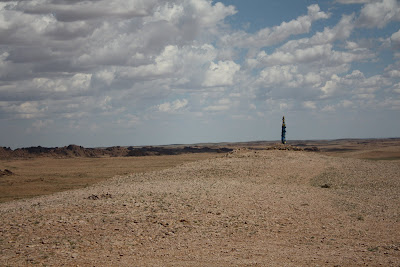Ok, now I'm really behind. Still making Gobi posts, and already past Korea and in Vietnam right now...Oh well, I think I'll have some time here to get caught up.
Our 4th day in the Gobi opened with the blazing sun, as usual. We had our breakfast, packed up our tents, played some ankle bones, and learned how to shoot ankle bones. I ended up buying a set in Ulaanbaatar, so now I can bring the fun back to the states: should be fun, as long as I remember how to distinguish throwing a "camel, horse, sheep, or goat..."
After breakfast, our hostess showed us the traditional method of making felt. She makes felt this way still, and it's used for boots, saddle blankets, and most importantly, ger wall insulation. So of course, I was fascinated: homemade insulation! She took wool that she had beaten to different consistencies, layered it, beat it some more, added water, squished out the water, rolled it, squished it some more, rolled it some more, then unrolled it: felt! She made a 16"x16" square, and all I could think about was how long it would take to make a whole ger's worth. This mystery was solved, however, when we visited the Fine Arts Museum in Ulaanbaatar, and we saw some 19th century paintings depicting everyday life: they made giant rolls of felt, that had to be rolled and squished using horses. So, she was just making us a small sample.
We all loaded up in the family truck, which was filled to overflowing with wool: they were headed to town, and would drop us off at our next ger along the way. We made a few stops though, to walk through and climb on the rock formations. This portion of the Gobi was the bottom of a sea, and the formations were incredible. I kept imagining the rocks thinking it was way more fun to watch all the fish swim by than the occasional human clamber around. This was where we saw the water beneath all the rocks [earlier post].
We arrived at our overnight ger around midday, and our teenage host asked if we wanted to go on a walk. We knew now that that could mean anything, so we brought backpacks and water. Good thing: "walk" can mean 10 miles in open desert, as it did this afternoon. We climbed a giant hill, and got a view of the whole plain, we scrambled up rock faces and inside caves, we visited a massive outdoor amphitheatre, which is a UNESCO world heritage site for the origination of the traditional Mongolian long song. I got out my tinwhistle to test the acoustics, and after playing a song or two, handed it over to our guide, who promptly played a couple of tunes for us! That's why I love the tinwhistle - every once in a while, something like that happens. We were both so delighted, we played some more, and I sang a couple of songs. It was a place you could really belt it out.
We got back "home" and tried to quench our thirst with hot mare's milk, and then I climbed some rocks to watch the sunset on my own. Nothing like having miles and miles and miles of land in every direction, turning red with the sunset to the west, and black with a gathering storm to the east...
It did storm that night, thunder, lightening, rain: but our little tent held together, and we were none the worse for wear.
 |
| Making felt. Here, she's adding water to the wool. |
 |
| Where we woke up on day 4. The sun is really this bright. |
 |
| Rock formations in the Gobi. |
 |
| The former seafloor, Gobi Desert. |
 |
| The desert! |
 |
| Our overnight ger: last night in the desert. |
 |
| Sunset in the desert. |
 |
| Some goats. They snuffle a lot. |
 |
| Baby goat! |





















































